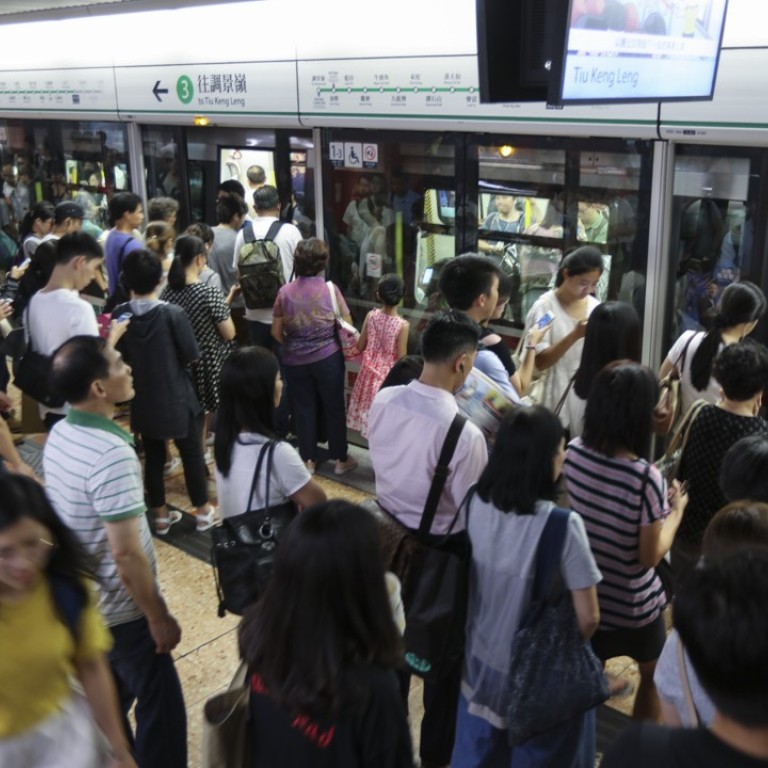
Hong Kong can show China how to move 1 billion people by rail, and profit from renting property
Metropolises in China are rapidly transforming based on the concept of transit-oriented development, with Hong Kong’s MTR seen as the benchmark
The urbanisation of China is facing a critical challenge: how to fit 1.05 billion people into metropolitan areas. And Hong Kong might offer the solution.
Statistics show there were more than 770 million city dwellers in China by 2016, or 57.35 per cent of its total population. That number will surge to 1.05 billion by 2030. Though it is a positive indicator of country’s development, it could cause headaches for urban planners.
The growing urban sprawl in China has brought increased use of private cars, chronic air pollution, traffic jams, growing issues over available housing and increased stress on the country’s existing infrastructure.
Most of the challenges above can be solved or mitigated by better public transport systems, but China’s urbanisation so far is heavily automobile-dependent.
“While Chinese cities are investing heavily in infrastructure for mass transportation, they are failing to integrate land use with public transport.
“Furthermore, the accessibility for non-motorised travellers is not well catered for,” noted Christian Bruce, a German urban planner, in a earlier research report on the subject.
That’s why transit-oriented development (TOD) has been gaining significant attention in China.
Originating from Europe, transit-oriented development projects aim to maximise the amount of residential, business and leisure space within walking distance of public transport, by building high-density, mixed-use areas around a central transit stop.
Compared to other built-up areas, a TOD is more walkable, using smaller block sizes and reduces the land area dedicated to automobiles.

“Automobile-oriented cities prefer flatter city planning because the ideal situation for car owners is there are no other cars nearby,” said Daizong Liu, China transport programme director at World Resources Institute.
“Obviously, we wouldn’t be able to accommodate that if we had limited urban land. Now is a critical time for China to transform and achieve sustainable urbanisation through the implementation of TOD.”
As one of the four biggest cities in China and a thoroughfare that links Hong Kong and China’s mainland, Shenzhen is pioneering in this transformation.
“Projects such as Shenzhen Metro Line 1’s Laojie stop, Shenzhen North Station, and Mangrove Bay are showcases that best illustrate Shenzhen’s effort into integrating transportation with city development,” said Jianhua Yang, the President of Shenzhen Metro Vanke Investment Development.
According to Yang, Shenzhen has a total land area of 976 square kilometre on which residential and other developments can be built. Some 968 sq km of that had been used by the end of 2014.
The limitation of usable land has pushed Shenzhen to transform from an automobile-oriented city into one more focused on public-transit. So far, there are 11 TOD projects undergoing in the city.
When it comes to sustainable urban development, however, cities in the mainland still have a lot to learn from Hong Kong.
Its emphasis on infrastructure has made it an important benchmark for how the TOD concept can be implemented in Asian cities, specifically in mainland China.
“Shenzhen Metro has based a lot of case studies on Hong Kong, ”said Yang, “especially the self-sustained business model that the Hong Kong MTR has.”
Metropolises around the world have been building or expanding public transit systems to cope with population growth and urbanisation.
But as metro systems get bigger and serve more people, most continue to lose money.
Hong Kong is one of the few that profits on its own without any government funding: it registered a HK$10.25 billion (US$1.32 billion) net profit last year.

The key to Hong Kong’s success is a business model called “Rail plus Property” (R+P).
The MTR builds a new rail line and partners with private developers to build properties above or around the new line. MTR receives a share of the profits that developers make from these properties.
In other words, in exchange for transporting customers, the MTR receives a cut of the profits from the mall or residential block build above it.
The funds generated through the properties are then used on new projects as well as for MTR operations and maintenance.
Buildings sit over about half of the 87 stations in Hong Kong, amounting to 13 million square meters of floor area in 2016.
Revenues from R+P developments above stations along MTR’s Tseung Kwan O line, for example, financed the extension of that line to serve a new town, which has since grown to a population of 380,000.
“Through R+P, Hong Kong has demonstrated how integrating railway expansion with property development can help make public-transit systems financially self-reliant while also promoting sustainable urban growth,” said Lincoln Leong, the MTR’s CEO in 2016.
Hong Kong MTR’s railway system now covers 221 kilometres and is used by more than five million people every weekday.
It not only performs well – trains run on schedule 99.9 per cent of the time – fares are also relatively low compared with those of metro systems in other developed cities, such as London, where fares are exorbitant.
However, the “R+R” model has also brought complaints, such as people are getting robbed of natural lighting during their day, and that the air ventilation or circulation systems doesn’t work well enough.
“Transit-oriented development means more than high density and good mixes of types of business,” said Daizong Liu.
“The genuine essence of TOD is transforming our cities into a more refined and humanised places to live.”

